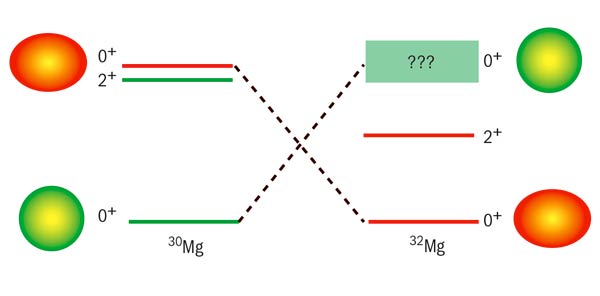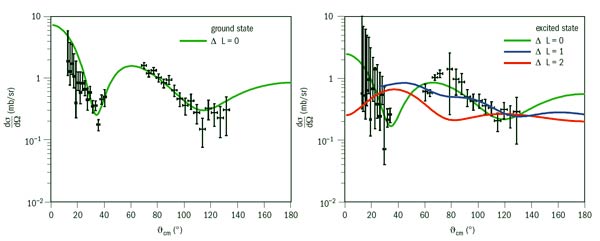Homing in on a missing piece in the study of exotic nuclei.

The nuclear shell model, one of the cornerstones in describing nuclear structure, was invented independently by Maria Goeppert-Mayer and Hans Jensen in 1949, who both received the Nobel prize in 1963. In the model, nuclei with “magic” numbers of protons or neutrons exhibit highly symmetric spherical configurations similar to the electron cloud in noble gases or the carbon atoms in C60 molecules (“buckyballs”). The traditional “magic” numbers in nuclear physics – 2, 8, 20, 28, 50, 82 (and 126 for neutrons) – are well established for stable nuclei. These emerged from a purely phenomenological approach, but modern nuclear theory can trace the magic numbers down to nucleon–nucleon forces derived from low-energy QCD.
Many current studies of nuclear structure with exotic radioactive nuclei focus on the question of whether these magic numbers persist or are altered in going away from the “valley of stability”, where the numbers of protons (Z) and neutrons (N) combine to give the most stable nuclides. Challenging the predictive power of nuclear theory, the aim is to lead the way towards a universal description of nuclear structure. Predictions for nuclei that lie beyond the reach of experiments are also important, for example, for the understanding of nucleosynthesis in exploding stars, at the origin of the chemical elements in the universe.
Such changes have already been observed experimentally in exotic nuclei. For example, the stable isotope 16O (Z=N=8) is an exemplary doubly magic nucleus. However, far from stability, 24O (the oxygen isotope that has the most neutrons while still being bound) behaves in a similar fashion, indicating that locally a new magic number, N=16, appears. Other examples are the disappearance of the magic number N=8 in 12Be and evidence for a new magic number, N=34, in 54Ca.

Image credit: K Wimmer.
Anomalies in nuclear structure in the region around N=20 have been known of experimentally since 1975, when mass measurements of exotic sodium isotopes at CERN’s Proton Synchrotron revealed a tighter binding than expected. This was followed by the discovery in studies of magnesium isotopes that the energy of the first excited state, populated by the decay of sodium, drops from 1482.8 keV in 30Mg to 885.3 keV in 32Mg (N=20) – the opposite of what is expected on approaching a magic number. These features were then attributed to an unexpected onset of deformation, with the nuclei having most likely the shape of a rugby ball rather than being spherical.
Further evidence for this interpretation came from studies of electromagnetic transition strengths and ground-state properties, some of them performed at CERN’s world-leading ISotope OnLine separation (ISOL) facility, ISOLDE. In terms of the nuclear shell model, the nucleon–nucleon forces are believed to change the ordering of some single-particle orbitals, sometimes so drastically that orbitals are lowered even across a closed shell (in this case N=20). The neutron-rich nuclei in the N=20 region, whose ground-state configuration includes valence neutrons that occupy such “intruder” orbitals, form what is known as the “Island of Inversion”.
Shape coexistence
In 30Mg (N=18), all of the experimental and theoretical work points to the coexistence of a spherical ground state with spin (J) and parity (P), JP = 0+, together with a deformed excited 0+ state at 1788.2 keV, which has a wave function with a strong intruder contribution. The latter has been identified at ISOLDE by measuring the conversion electrons of the characteristic electric mono-pole (E0) transition between the two 0+ states, as in this particular case the emission of a gamma ray is forbidden because of angular momentum conservation. In 32Mg – in agreement with theory – all of the data indicate that inversion has taken place so that the energetically favoured intruder configuration dominates the deformed ground state. Consequently, a near-spherical excited 0+ state, the analogue of the ground state in 30Mg, is expected, as illustrated in figure 1. Despite numerous attempts, however, this state has never been observed experimentally – until now.

Image credit: Janne Pakarinen/ISOLDE.
An experiment led by the Technische Universität München and the Katholieke Universiteit Leuven and involving 39 experimenters from 14 institutes in 9 countries has at last discovered the excited 0+ state in 32Mg (Wimmer et al. 2010). The experiment was performed in October 2008 at ISOLDE, where fundamental and applied research with radioactive ions is performed at CERN. Operating since 1967, ISOLDE has produced more than 700 isotopes of almost 70 elements as low-energy beams (60 keV). Starting in 2001, nearly 80 isotopes of elements from lithium to radium have been post-accelerated by the Radioactive Beam Experiment (REX) to energies up to 3 MeV/u, enabling the study of nuclear-reactions.
The key idea was that the addition of two neutrons to the spherical ground state of 30Mg should populate either the deformed ground state of 32Mg or the spherical excited 0+ state, depending on which orbital the additional neutrons occupy. Experimentally, this was achieved by a two-neutron transfer reaction in inverse kinematics. A beam of 30Mg impinged on a tritium (t) target from which the two neutrons were transferred to form a 32Mg nucleus in a (t,p) reaction.
The radioactive 30Mg (T1/2 = 335 ms) was produced by the 1.4 GeV proton beam from the PS Booster impinging on a thick, uranium carbide production target. The magnesium atoms were selectively ionized by the Resonant Ionisation Laser Ion Source and the singly charged ions were mass-separated to obtain a pure 30Mg beam. The energy of the ions was then boosted by the REX-ISOLDE facility to 1.83 MeV/u, with a final intensity of around 104 particles a second.

The experimental set-up consisted of MINIBALL – a high-resolution gamma-ray spectrometer with 24 segmented high-purity germanium detectors – in combination with the newly built Transfer reactions at REX (T-REX) array, which is the key detector for this experiment. T-REX is a 4π array with 58% coverage in solid angle. It consists of a box-like “barrel” of quadratic silicon-strip detectors together with an annular double-sided segmented silicon-strip detector, the “CD”; in both cases there are two layers of silicon detectors (figure 2). Energy and position are measured for charged, target-like particles – protons, deuterons and tritons; these are identified by measuring the energy loss in a thin detector, which is characteristic for a species at a given energy, and the remaining kinetic energy in a thick detector that stops the particles (the ΔE–E method). The compact set-up was housed in a cylindrical vacuum chamber with a diameter of 12 cm to fit inside MINIBALL.
One of the experimental challenges was to make a thin radioactive tritium target, small enough to fit in the centre of T-REX. The technical solution was found in the form of a tritium-loaded titanium foil. The measured energies and angles of the protons emitted from the (t,p) reaction enabled the reconstruction of the excitation energy of the 32Mg nucleus. The angular distributions of the protons allowed for the determination of the transferred orbital angular momentum ΔL, from which the spins and parities of the populated states could be deduced (figure 3).
The shape of the measured angular distribution is characteristic for ΔL=0 and firmly establishes the 0+ assignment for the excited state, just as for the ground state (figure 3). An excitation energy of 1058 keV and a lower limit for its lifetime of 10 ns have been deduced. The population cross-sections for both states and results from recent knockout reactions contribute to a consistent picture of a deformed ground state and a spherical excited 0+ state.
Such a low-lying – lower than predicted by any calculation – and long-lived 0+ state poses a challenge to modern theory. An experimental challenge also remains: to determine the lifetime of the excited state as well as the strength of the E0 transition between the two 0+ states. However, bringing all of the existing pieces of the puzzle together is already enabling a deeper insight into the physics relevant for the formation of the Island of Inversion.
The fascinating phenomenon of different nuclear shapes coexisting at similar energies – the difference is less than 1 per cent of the total binding energy – is also present in other regions of the nuclear chart, the most prominent example being the triple shape coexistence in the neutron-deficient 186Pb isotope. Transfer reactions at REX-ISOLDE are currently limited by the available beam energy to nuclei with mass number A lower than 80, but the upgrade of the facility to HIE-ISOLDE is already on the horizon. This includes an incremental increase of beam energy to 10 MeV/u and will become available in 2015. In particular, at these energies one- and two-nucleon-transfer reactions with heavy radioactive-ion beams will become feasible, opening up a whole new field for studies of single-particle aspects, shape coexistence and the role of pairing interactions. The future of nuclear structure studies with radioactive ion beams at CERN looks bright.





